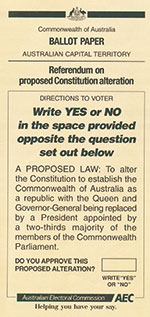Australian Electoral Commission


Polling day for a referendum is always on a Saturday and must be at least 33 days and no more than 58 days after the issue of the writ. Polling day for the 1999 referendum was on Saturday 6 November 1999.
At the 1999 referendum, there were 7 716 polling places operating on polling day. They were set up mainly in schools or community halls with the DRO in each division having selected suitable premises as part of their referendum preparations.
As far as practicable, DROs selected buildings which had wheelchair access. All polling places were advertised in major newspapers on the Friday before polling day and the places with full wheelchair access and those accessible with assistance were identified.
The list of polling places at the 1999 referendum was also published on the AEC web site. The web site had a search engine that enabled electors to identify their nearest polling place by typing in their postcode, suburb or town.
Polling places opened at 8am and closed at 6pm sharp. Electors inside the polling place at 6pm were able to complete their vote but no one else was able to enter to vote.
Polling officials were available at all polling places to assist electors with any query or information they needed in order to vote.
The officials staffing polling places were:
The attitude of voters towards the officials running AEC polling places continues to be highly positive. The friendliness, efficiency, helpfulness and integrity of polling place staff were rated very highly by electors who participated in the AEC's post-referendum survey. The telephone survey was undertaken in the 24 hours following the close of polls to assess the quality of service provided to voters on polling day.
Each elector was asked the following three questions by a polling official before they were issued with their two ballot papers:
The official then placed a mark next to the elector's name on the certified list, initialled the ballot papers and handed them to the elector. Each elector was issued with one buff ballot paper for the republic question and one mauve ballot paper for the preamble question.
The elector then went to a separate voting compartment to mark their ballot papers in private. Each voting compartment was provided with a pencil but electors were able to use their own pen if they wished. The elector then folded their completed ballot papers and placed each ballot paper into the appropriate ballot box.
In addition to issuing ordinary votes, a declaration vote officer issued absent and provisional votes at each polling place. Electors casting these types of votes were required to fill in a declaration envelope that they put their completed ballot papers into before they were put into the ballot box.
A total of 888 425 absent votes and 106 046 provisional votes were received at the 1999 referendum. National and State and Territory summaries of the provisional and absent votes counted for the republic question and for the preamble question are available. Divisional breakdowns for the republic question and for the preamble question are also provided.


Electors at the 1999 referendum voted on two different proposed constitutional changes which were printed on separate ballot papers. The republic question was printed on a buff ballot paper and the preamble question was printed on a mauve ballot paper.
On each ballot paper was a printed statement and electors were asked whether they approved of that proposed change to the Constitution. If electors approved of the statement they wrote 'yes' in the box provided and if they did not approve of the statement they wrote 'no' in the box provided.
The two questions posed were independent of each other and the result of one did not affect the other.
Scrutineers at the 1999 referendum were able to observe both the voting and the counting of votes at every polling place. The following officials were able to appoint one scrutineer for each polling place:
or persons duly authorised by them,
and
Scrutineers were required to wear an identification badge and their rights and responsibilities are outlined in the Referendum Act.
On referendum polling day, the 84 725 electors in the Division of Holt also voted in a by-election to elect their member in the House of Representatives. The previous Member for the Victorian division had resigned from Federal Parliament on 30 September 1999.
The timetable for the Holt by-election followed the referendum timetable with the issue of the writ, the close of rolls and polling day on the same day as the referendum.
At the close of nominations, five candidates had nominated for election in the Division of Holt.
The result of the Holt by-election is detailed below:
| Candidate | Party | First Preference Votes | |
|---|---|---|---|
| # | % | ||
| Mulholland | Democratic Labour Party of Australia | 5 404 | 7.31 |
| Scoullar | Australian Greens | 4 701 | 6.36 |
| Dickson | Child Protection (Elaine Nile) Party | 4 399 | 5.95 |
| Morgan | Australian Democrats | 10 896 | 14.74 |
| Byrne | Australian Labor Party | 48 499 | 65.63 |
| Formal votes | 73 899 | 92.81 | |
| Informal votes | 5 727 | 7.19 | |
| TOTAL | 79 626 | 93.98 | |
The successful candidate, Anthony Bryne from the Australian Labor Party, was declared as the new member for Holt on 12 November 1999. The Electoral Commissioner returned the writ for the by-election to the Governor General on 16 November 1999.